Recently, one of our users asked us how they can upload large images in WordPress. While this used to be a common issue years ago, most modern WordPress hosting providers now offer generous upload limits (often 64MB to 512MB) that accommodate most image sizes.
In fact, if you’re hitting upload limits today, it’s worth considering whether you actually need such large files. Most high-quality web images are well under 5MB, and proper optimization can reduce them further without losing visible quality.
However, if you do need to upload exceptionally large files (like high-resolution photography or design files), we’ll show you how to adjust these limits. Just keep in mind that very large images can slow down your website and affect user experience.
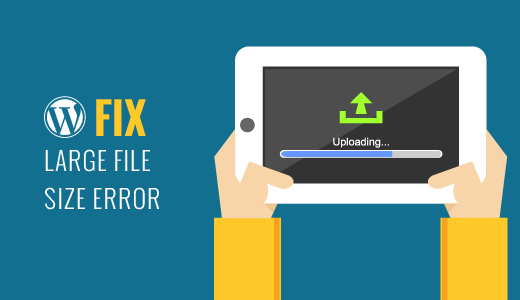
Understanding WordPress Image Upload Limits
If you’re seeing an error message that says ‘filename.jpg exceeds the maximum upload size for this site’, you might be surprised to learn this isn’t usually a limitation anymore.
In fact, the Bluehost shared hosting plan we use to test WordPress tutorials has an upload limit of 512MB, and that’s not their most expensive plan. Most other WordPress hosting providers today set similarly generous limits, typically between 64MB to 512MB.
To put this in perspective, here’s what typical optimized web images look like:
- Blog post images: Usually 1-2MB
- Product photos: 2-3MB
- Header images: 2-4MB
- Photography portfolio: 3-5MB
But if you’re still encountering upload issues, you can check your current limit by visiting Media » Add New page. These restrictions might be due to hosting provider settings, memory limit constraints, or server configuration settings.
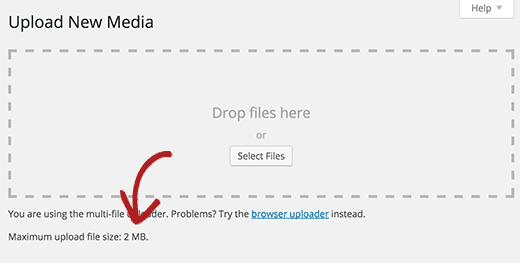
If you’re encountering either of these errors, then this article will help you fix that so you can easily upload large files to WordPress.
🚨 Wait! Before moving on to the rest of the tutorial, we strongly recommend using an image optimization tool first to reduce your file sizes without losing quality. This will help your website load faster and rank better in search engines.
See our guide on how to optimize images for web performance for step-by-step instructions.
How to Increase Maximum Image Upload Size in WordPress
If you want to upload large images and media files in WordPress, then here is how you will fix the image upload size issue in WordPress.
This method requires you to add code in WordPress. If you haven’t done that before, don’t worry, because we’ll use a free code snippet plugin called WPCode to do this safely.

To get started, you need to install and activate the free WPCode plugin. For instructions, see this tutorial on how to install a WordPress plugin.
Once the plugin is activated, go to the Code Snippets » + Add Snippet page from your WordPress dashboard.
From there, click the ‘+ Add Custom Snippet’ button under the ‘Add Your Custom Code (New Snippet)’ option.
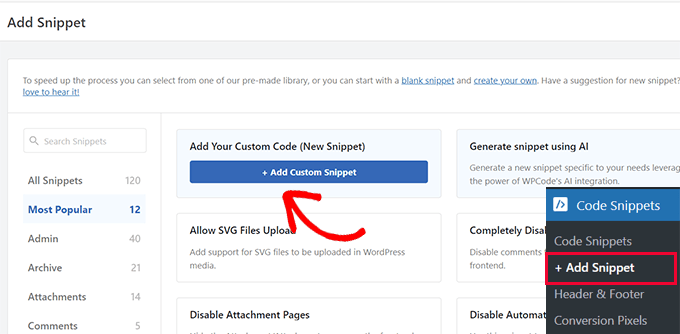
Next, add a title for your code and paste the code snippet from below into the ‘Code Preview’ box:
@ini_set( 'upload_max_size' , '256M' );
@ini_set( 'post_max_size', '256M');
@ini_set( 'max_execution_time', '300' );
Make sure to replace ‘256M’ with your desired maximum file size.
Don’t forget to select ‘PHP Snippet’ as the code type from the dropdown menu on the right side of the screen.
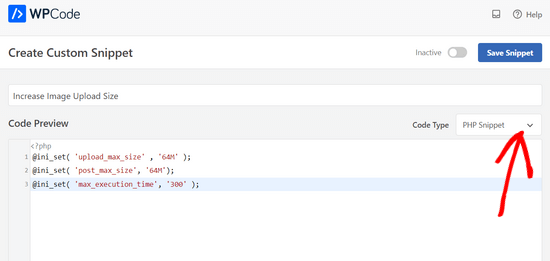
Finally, simply switch the toggle from ‘Inactive’ to ‘Active.’
Then click the ‘Save Snippet’ button.
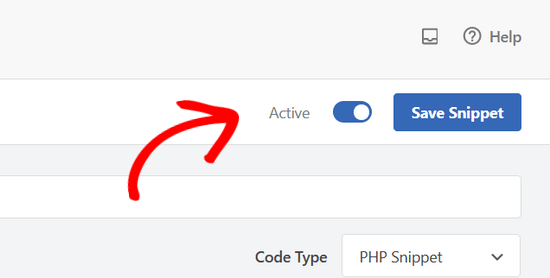
This code tries to increase the upload maximum file size, post maximum size, and maximum execution time limits for your WordPress site.
That said, this method may not work for all websites. In that case, you can take a look at our guide on how to increase maximum file upload size in WordPress for more information.
Do You Really Need to Upload Large Image Files in WordPress?
Let’s put image sizes in perspective. Most optimized web images are under 5MB, even for high-quality photography.
Even if you’re a professional photographer wanting to showcase your work, remember that web visitors don’t need the same resolution as print media. A properly optimized 3MB image can look just as stunning on screen as a 15MB one while loading much faster.
Large image files affect your website in several ways:
- Slower page load times
- Higher hosting storage usage
- Reduced search engine rankings
- Poor user experience on mobile devices
Here’s what we recommend Instead:
- Optimize your images before uploading as we recommended.
- Use a gallery plugin like Envira Gallery for photography websites. It automatically handles image optimization and creates responsive galleries that load quickly on all devices.
- Consider using a CDN (Content Delivery Network) if you have a large image library. CDNs serve your images from servers worldwide, improving load times and user experience. See our guide on how to install and set up WordPress CDN solution for detailed instructions.
That’s all, we hope this guide helped you learn how to upload large images in WordPress. You may also want to see our guide on effective WordPress design elements and our picks of the best drag-and-drop WordPress page builders.
If you liked this article, then please subscribe to our YouTube Channel for WordPress video tutorials. You can also find us on Twitter and Facebook.





Moinuddin Waheed
I have encountered this problem and never realised that this is because of the default size of 2MB.
Thanks for letting us know about how to add and increase the file size using the code snippets.
I have been using wpcode for inserting any type of code snippets and it is the best approach to add codes without breaking your site.
edizzz
How do I put a button to download the image of the post like the wallpapers sites?
Tyler Simonds
Re-sizing images prior to upload is a pain–a whole ‘nother step that WordPress should do automatically.
Brittney
Hello,
I tried using this code the 1st code into the functions folder, and now my website no longer works. I am getting “Parse error: syntax error, unexpected ‘@’ in ___” even after I have deleted the code and tried to update it back to normal. Any suggestions?
Wali shah afridi
i upload the above code but still the large image file does not upload in my block , kindly tell my that what i do know ??
Chase
I would like to clarify that making changes to functions.php files has no effect and that editing my .htaccess file causes an internal server error no matter how perfect I try to make the code. Should I be uploading large video files using another method? The main reason I want to upload the video is to share with a small group of people. I can’t upload it with YouTube, and therefore can embed into Wordpress via YouTube because they claim a copyright on my music and the audio is automatically hushed. I need that specific audio track with my video, so YouTube is not an option. So I guess if I can’t solve this problem I need to either find a video hosting service that does not flag copyrighted material or try to host it myself, both of which are a bit off topic for this message board. I am assuming in am out of luck at this point.
Chase
Nothing works to upload large files on my GoDaddy Wordpress multi-site account running the new version of php. I certainly can’t add directly though my Wordpress media browser, so I upload the recommended way via FTP first. The problem is I can’t get the files from my ftp folder to the Wordpress media browser. Very little relevant information is posted about the topic online. The recommended “Add from server” plugin does not work. The backup version does not work. The developer does not know. I have all my settings at the right levels in the cPanel configuration settings. I verified with GoDaddy three times. GoDaddy said I can’t do anything more on the hosting end and that it should work. Since the actual php.ini file is not accessible in GoDaddy, creating a new php5.ini or regular php.ini is recommended for GoDaddy servers, but this does not work for me. I can’t edit my actual php.ini file as the video shows. My files size a 150MB mp4 video file and can’t get it much smaller. I adjusted all of the WordPress settings for uploading large files and video files. This did not work. Does anybody know what to do? In the meantime, I am trying to find an another plugin that actually works.
WPBeginner Support
You can simply paste the link of the uploaded file into your WordPress post editor and it will embed it for you. For example if you uploaded the file /wp-content/uploads/my-video.mp4 then you can just add http://example.com/wp-content/uploads/my-video.mp4 in a blog post (replace example.com with your own domain name) and WordPress will embed it for you. Give it a try let us know how it goes.
Admin
Lutaaya paddy
thank you for this article it has worked for me . the code which is put in the .htaccess
Penelope
The reason I would like my max upload size increased is because I have a button that opens a URL link of my catalog for customers to download. This link is from my media folder in wordpress.
If I use a link in a button, does this slow down my website? Do you have a recommendation on how to go about allowing viewers to view a pdf catalog without slowing down a website?
Ankit Agarwal
Though for photographers, using a template ( or theme ) that does not allows large image sizes is not understandable. And for rest of us using a plugin seems logical since we will never want to upload a 10 MB+ ( even that’s too high) for the fear of reducing speed. Other wise can there be another reason of uploading high res images?
gary odom
You call this WP for beginners but when you proceed to talk about things like php file and ftp client you assume a beginner knows of what you speak. I am sure there many that do, but do real beginners really know what you are talking about? Of course, you are entitled to do what you wish, but it certainly does not cater to true beginners that are still finding they way around the WP program. Many of us had our hosting service install WordPress for us so we are not acquainted with much of what you speak. i am anxious to learn but first I must understand the basics.
WPBeginner Support
Thanks for the feedback. We do miss things occasionally, but you can always ask us to clarify in the comments. We will be happy to offer further explanation.
PHP is the programming language in which WordPress is written. FTP client is a software that allows you to connect to your web server to edit and upload files on your shared hosting server. Take a look at our guide on how to use FTP to upload files to WordPress for beginners.
Admin
Rybird
Very well written informative article.